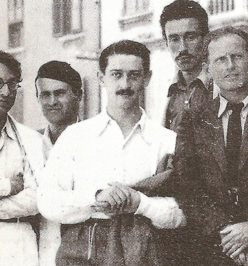ERICH-SLOMOVIC.COM


ERICH-SLOMOVIC.COM




There's a lot we don’t know for sure about Erich Slomovic, starting with when and where he was born. Some say it was in the Jewish friendly Ottoman Empire’s region of Bosnia in 1901. Others that it was fourteen years later, in Djakovo , in what was then Austria Hungary. But one thing is for sure: in 1935, aged maybe 20 or maybe 34, he arrived in Paris at the express invitation of Ambroise Vollard, the legendary art dealer and publisher, and in four short years established himself as one of history’s greatest collectors.
Erich was a committed art lover from a tender age, and he idolized Vollard, who had staged the very first Paris exhibitions of Cezanne, Picasso, Matisse and others. He began a correspondence with the great man, once sending him a letter that said simply, "I want to be like you." That letter would be found many years later, its preserved envelope postmarked 1928 in the Kingdom of Yugoslavia.
But the wide-eyed art enthusiast of the Balkans certainly never expected to get an invitation to Paris from the great Vollard. So when it arrived he immediately packed his bags, carefully nestling among his belongings the notebook he called KOLEKTANEA. In it he intended to collect inscriptions from famous people he might meet. He had already put it to some use in Belgrade, where a couple of contemporary writers and cartoonists had contributed a few lines and sketches, and a philosopher had offered an apocalyptic – and, it turns out, strangely accurate – prediction of the future of the world. But Erich Slomovic could never have known who else would contribute to his notebook in the five years of its active life.
Or maybe he did know. For a person driven by such an unbridled passion for art, he was extremely meticulous and deliberate in his lifestyle. He never married and was not known to have had any ardor or vice, apart from his love for art, which he never tired of hearing about, sitting up until all hours to soak up the ideas and opinions of the greatest artists and thinkers of prewar Paris.
Maybe it was his attentiveness that won him so many friends among that golden elite, or perhaps it was his own wit and charm. His group of friends grew bigger every day, as witnessed by the entries in his precious KOLEKTANEA: Chagall, Matisse (top left photograph), Klee, Picasso...
And as Erich was making important friends, Maître Vollard was becoming more and more dependent on his young associate. He trusted Erich's judgment, taste and business acumen. Vollard had had a son once, but he had never had a protégé like young Erich, someone who reminded him so much of himself 40 years before. Vollard heartily encouraged the young man to trade, deal and collect on his own. To start him out on this exciting journey he gave him numerous gifts of artwork, books and documents. Erich then continued to supplement it, through trades, purchases and quite a few gifts from artists themselves, most notably Rouault.
And when Ambroise Vollard died in a car crash in July of 1939 at the age of 73, his last will and testament were woefully out of date, having been written in 1911. The heirs then started their never ending entanglement, but no one has ever questioned “the provenance” of Erich’s collection, until much, much later, in the 1980’s France.
But, for now, let’s go back to 1939. The big party that had been Paris in the 20s and 30s was quickly coming to an end. Life was becoming uncertain and dangerous for Jews in France. Erich might have been excused if he had tried to escape with his collection to America or Switzerland, or sell it, as so many others did. But he would sooner have died than have parted with those masterpieces; he wanted to share them with the world, not sell them piecemeal into private collections.
So he packed up the paintings and boarded a train for his beloved Belgrade, where the war had not yet spread. He would build a Modern Art Museum there, he decided, somewhere to showcase this amazing collection. He invited his friend Le Corbusier to come to Serbia and draw up some sketches, and the greatest architect of the 20th century obliged.
Before the museum could be financed and built, though, the 419 works that comprised Erich's collection were first exhibited in Zagreb. The show opened on November 24, 1940 in a former mosque -- the only public space big enough to house the exhibition. It was a staggering success. Erich was flying high (shown above right - Erich in Split in 1940 with friends celebrating the success of the Zagreb exhibit ) , almost as high as he was when he first arrived in Paris, a mere five years before. He almost certainly wasn't worried about the few pieces of art, mostly sketches and lithographs, that he had left behind in a bank vault of a Paris branch of Société Générale. He signed a lease for the vault until 1943; what he intended to do with this lot ultimately remains a mystery. Did he think something significant was going to happen in 1943, or indeed in 1941? We will never know.
But in any case, this is what he did. The Zagreb show over, he repacked his art in the same crates he brought them in from Paris and took them back to Belgrade. He entered into prolonged negotiations with Paul, the Prince Regent, and his advisers about the location and layout of the new museum. He got so involved in his plans that probably all the way until March of 1941 he never really stopped to think about himself and what might happen to him and his family if war should come.
When the events of March 27th made it clear that Yugoslavia would not be spared by Hitler, Erich and his family escaped to the sleepy Serbian village of Bachina where they thought they might be able to weather the oncoming storm. The paintings came along with them, and were eventually hidden in a farmhouse behind a double wall. And there most of it stayed until the Red Army and Yugoslav Partisans liberated Serbia in 1944.
Erich and his father and his brother were not so lucky. News of the existence of the extraordinary Slomovic art collection had reached the ears of Reichsmarschall Hermann Goering, who sent a special Gestapo unit to Serbia to find the paintings and take them back to Germany. The Gestapo may have been unsuccessful at locating the art, but Wehrmacht, conducting a house-by-house search for Jewish adult males to be executed as a retribution for killed German officers, had no trouble zeroing in on Erich and his brother and father and determining their ethnicity simply but crudely by having them drop their trousers.
Erich's death certificate bears the date of 9th of May 1946. But, like one or both of his birth certificates, it is almost certainly inaccurate: all missing persons from WWII in Yugoslavia were legally declared dead a year and a day after peace was declared. It is thought likely though, that the young optimist didn’t even survive the journey to the killing fields in the fascist independent state of Croatia, but died somewhere along the way.
Some of Erich's female relatives, including his mother, managed to avoid capture by the Nazis. Rosa Slomovic, guardian of her son's art collection, secured the help and the protection of Tito's government through his second-in-command, Moshe Pijade, an old family friend ( the bottom left photograph is a of a portrair of Slomovic by Pijade, done in 1941.) Pijade sent a special train to Bachina to collect Rosa and the paintings and bring them back to safety in Belgrade. But, speeding through the foggy Serbian countryside on December the 31st, 1944, the train collided head-on with another train, killing Rosa instantly and flinging masterpieces of the 20th century's greatest artists out of their crates and into the muddy fields of central Serbia, where they mingled with the dead bodies of soldiers and passengers. Three years later, most of the art was recovered in Belgrade, after an intensive search by the Yugoslav secret police, and handed over to the Communist authorities.
When an inventory was finally taken some years later by the curators of the People's Museum in Belgrade, the count stood at slightly under 350 works by Cezanne, Degas, Gauguin, Renoir, Matisse, Bonard and Derain, among others. One or two paintings that should have been there were missing, and it has been posited that they had been left behind in the Paris vault. Others may have been looted from the scene of the accident, or stolen from their hiding place in the farmhouse. Nobody knows for sure. As for Erich's precious KOLEKTANEA, it was not found.
In 1979, French bank Société Générale, citing the excuse that rent had not been paid in nearly forty years, publicly opened the vault that Erich had leased, and proposed an auction of the artworks in order to recoup the unpaid fees, which amounted to no more than a few thousand dollars. But the auction was immediately contested by heirs both to Vollard and to Slomovic. Legal wrangles continued until 2010, when Sotheby's finally got clearance to sell the works, with proceeds split between the bank and the heirs. One painting by Derain fetched an eye-watering $24,000,000 with the total proceeds from all the auctions breaking the $40,000,000 barrier.
Meanwhile, the lion's share of the collection languishes unseen in the dark vaults of Serbia's National Museum in Belgrade, which has been "closed for refurbishment" for nearly ten years and shows no signs of opening any time soon.
As for the KOLEKTANEA, it supposedly “popped up” in Switzerland, where a private dealer put it up for auction in the 1950s. The Yugoslav government, in one version of events, immediately authorized its embassy in Switzerland to buy it back for the nation. But it never found its way back to the museum. Or, maybe, it was never in Zurich in the first place? It resurfaced again in Belgrade in 2009, when it was shopped around town by a notoriously shady local "businessman", purportedly on behalf of the current owners ( descendants of the “embassy employee”?).
A friend of mine, a publisher of high-quality art books, actually held the KOLEKTANEA in his hands and leafed lovingly through its extraordinary contents. And then, reluctantly, he gave it back, but not before meticulously scanning each and every one of its 132 priceless pages. Some of these images he kindly shared with us for this site. His dream is to publish a facsimile edition of KOLEKTANEA, while ours is to make a movie about the short, brilliant life of Serbia’s most phenomenal art collector. Maybe between us we can see to it that Erich's dream will not end up with so many others, buried and forgotten in some muddy graveyard in the Balkans.
copyright 2012, Mia and Miodrag Certic. All rights reserved.
Erich Slomovic (1915-1942)
Art Collector, Holocaust Victim
Born in Djakovo, Austria Hungary, murdered by Nazis somewhere in Serbia in 1942.
This site is dedicated to his memory, his achievements and to his defense in the never-ending saga of lies, accusations, thievery,
malice and character assassination this eternal optimist and art lover
endured during his short life and especially since his death.

The Life and Trials of Erich Slomovic